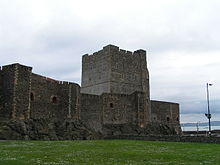Hugh de Lacy, 1st Earl of Ulster
Hugh de Lacy, 1st Earl of Ulster (* 1176 ; † 1242 ) was an Anglo-Norman nobleman.
He came from the Norman noble family de Lacy and was the younger son of Hugh de Lacy , the Lord of Meath .
Battle for Ulster
In 1177 John de Courcy , a Norman nobleman who had come to Ireland with King Henry II of England in 1171, had conquered almost the entire provincial kingdom of Ulster (see also Anglo- Norman Conquest of Ireland ). After the death of Hugh de Lacy, the Lord of Meath, who had practically ruled Ireland as viceroy, Henry II installed John de Courcy as Justiciar of Ireland .
But Hugh de Lacy's sons Walter (1172-1241), the second Lord of Meath, and his younger brother Hugh did not want to let this go. They achieved the installation of the younger Hugh de Lacy as coadjutor of John de Courcy for Leinster and Munster . When John Ohneland became King of England after the death of his brother Richard the Lionheart in 1199, he wanted to secure the allegiance of the de Lacys, who were more firmly anchored in Ireland, and allowed them to attack Ulster. For the first time it was not about a dispute between Irish and Normans, but about a feud between Norman barons on Irish soil.
After almost five years of fighting, John de Courcy was captured in 1203 but was able to escape to his brother-in-law, Ragnold, the King of the Isle of Man . With a deed dated May 29, 1205 Hugh de Lacy was officially elevated to Earl of Ulster by King John Ohneland of England in the Peerage of Ireland and his conquests in Ulster and Connaught were confirmed as a fiefdom . Hugh immediately built up Dundrum Castle on the Irish Sea in Down, begun by John de Courcy .
A number of legends have grown up around the capture of John de Courcy and his subsequent escape . Anyway, he came in 1205 with the fleet of his brother Ragnold back to Ireland and besieged Dundrum Castle, but failed because of the added now by Hugh de Lacy curtain walls .
King John's expedition
As early as 1208, King John and Hugh de Lacy fell apart. The de Lacy family had become too powerful for the king. Walter de Lacy granted asylum to his brother-in-law William de Braose and his wife Maud when they were persecuted by the king. Wiiliam knew about the mysterious disappearance of Arthur from Brittany , the grandson of Henry II and actual heir to the throne according to the law of the primogeniture . Walter de Lacy's wife, Margaret de Braose, accused the king of the murder of his nephew Arthur.
In 1210 King John equipped an army of 7,000 men for his second expedition to Ireland. On June 20th of this year he landed in Waterford on the south coast of the island. Nine days later the king marched into the capital, Dublin .
Hugh de Lacy blocked the access to Ulster, King John had a ship bridge built over Carlington Lough and marched into Down. He besieged Dundrum Castle and Carrickfergus from the water and from the land. Hugh de Lacy fled to Scotland and later came to France, but his wife Mathilda and son were captured by the king and died of starvation in the king-conquered Carrickfergus Castle . The same happened to William de Braose's wife and eldest son, who had been picked up in Scotland by the king's henchmen and taken to Windsor Castle .
Hugh de Lacy took part in the battles against King John and the Albigensian Crusade on the French mainland . Even after John's death in 1216 he was unable to return to his Irish possessions. In 1221, however, he allied himself with the leader of the Irish rebels, O'Neill, against the English occupiers. In 1226 the Irish possessions were given to Hugh de Lacy's brother Walter by the king, but transferred back to Hugh the following year. Henceforth he seems to have served the new king faithfully, he was often called to the court as an advisor on Irish affairs. Hugh, the first Earl of Ulster, appears for the last time on December 26, 1242 and died shortly afterwards. Leaving no heirs, his earl title expired on his death and his lands reverted to the crown.
literature
- Charles Lethbridge Kingsford: Lacy, Hugh de (d.1242?) . In: Dictionary of National Biography . Volume 31, Oxford 1892, p. 377 ff.
- Ulster, Earls of . In: Encyclopædia Britannica . Volume 27, London 1911, p. 568 f.
Individual evidence
- ↑ Peerage: Ulster at Leigh Rayment's Peerage
| predecessor | Office | successor |
|---|---|---|
| New title created |
Earl of Ulster 1205-1242 |
Title expired |
| personal data | |
|---|---|
| SURNAME | Hugh de Lacy, 1st Earl of Ulster |
| ALTERNATIVE NAMES | Earl of Ulster |
| BRIEF DESCRIPTION | norman nobleman |
| DATE OF BIRTH | 1176 |
| DATE OF DEATH | 1242 |


